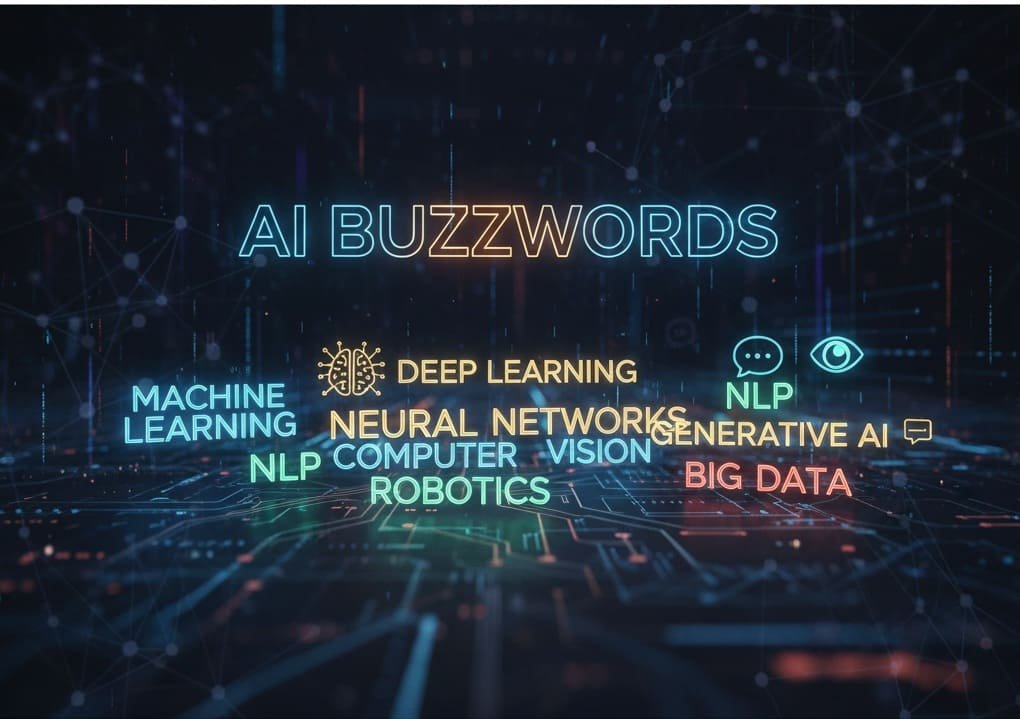
Common Artificial Intelligence Buzzwords
Artificial Intelligence (AI)
The science of creating machines that can perform tasks requiring human-like intelligence.
Deep Learning (DL)
A specialized branch of ML that uses multi-layered neural networks to automatically learn complex data representations. It mimics the human brain’s ability to recognize patterns and make decisions.
Large Language Model (LLM)
An advanced AI model trained on vast text data to understand, generate, and reason with human language.
Generative Pre-trained Transformer (GPT)
A large language model that understands and generates human-like text using the Transformer architecture. Llama and Gemini are other text model examples.
AI Agent
An autonomous system that perceives its environment, makes decisions, and takes actions to achieve specific goals.
Prompt Engineering
The practice of designing and refining input prompts to guide AI models (like GPT) toward producing accurate, relevant, and high-quality outputs.
Vectorization
The process of converting data (like text, images, or audio) into numerical vectors that AI models can understand and process.
Fine-tuning
The process of adapting a pre-trained AI model to a specific task or dataset by continuing its training on domain-specific data.
Unsupervised Learning
A type of machine learning where models are trained on labeled data—input-output pairs—so they learn to predict outcomes accurately.
Natural Language Processing (NLP)
A branch of AI that enables machines to understand, interpret, and generate human language.
Hallucination (in AI)
When an AI model generates false or fabricated information that appears plausible but isn’t grounded in real data.
Zero-shot Learning
The ability of an AI model to perform a new task without explicit training on it, using generalization from related knowledge.
Computer Vision
A field of AI that enables machines to interpret and analyze visual information from images or videos.
Prompt Design
The process of creating a prompt that is tailored to the specific task that the system is being asked to perform.
Instruction tuned Language Models
Trained to predict a response to the instructions given in the input.
Chain-of-thought reasoning
Models are better at getting the right answer when they first output text that explains the reason for the answer.
Machine Learning (ML)
A subset of AI that enables computers to learn patterns from data and improve their performance without explicit programming.
Generative AI
A type of AI that creates new content—such as text, images, or music—by learning from existing data.
Transformer
A deep learning architecture that processes sequential data using attention mechanisms, powering modern models like GPT and BERT.
Tokenization
The process of breaking text into smaller units (tokens), such as words or subwords, for machine understanding and processing.
Agentic AI
AI systems are designed with autonomy and reasoning abilities to plan, act, and adapt dynamically toward achieving objectives. It has one or more agents in it.
Context Engineering
The process of structuring and supplying the right background information, data, or instructions to an AI system so it understands the situation and responds appropriately.
Multimodal AI
AI systems that can process and integrate multiple types of data—such as text, images, audio, and video—to understand context and generate richer outputs.
Supervised Learning
A type of machine learning where models are trained on labeled data—input-output pairs—so they learn to predict outcomes accurately.
Reinforcement Learning
A learning method where an agent learns optimal actions through trial and error by receiving rewards or penalties from its environment.
Bias in AI
Systematic errors in AI models that lead to unfair or inaccurate outcomes, often due to biased data or design.
Human-in-the-loop (HITL)
An AI approach where human judgment is integrated into training or decision-making to enhance accuracy and accountability.
Few-shot Learning
When an AI model learns to perform a new task effectively from only a few examples.
Explainable AI (XAI)
AI systems are designed to make their decisions and reasoning transparent and understandable to humans.
Generic (or raw) Language Models
Predict the next word (technically, token) based on the language in the training data.
Dialog tuned Language Models
Trained to have a dialog by predicting the next response.
Model (LLM) Tuning
The process of adapting a model to a new domain or set of custom use cases by training the model on new data. There are two efficient methods of tuning: (1) Parameter-efficient-tuning methods (PETM) – Methods for tuning an LLM on your own custom data without duplicating the model, (2) Prompt tuning – One of the easiest parameter-efficient tuning methods